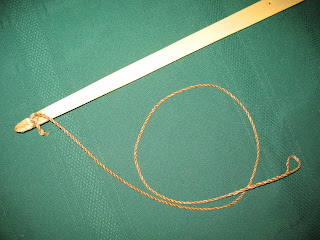
The first thing that we will do is to wrap the tips with sinew to keep the backing from coming lose at the tips. You can just take a few strands of sinew and chew on them for a minute. The chewing and the enzymes in your saliva will soften the sinew and activate the natural glue in it. Wrap both ends and set the bow aside for an hour to dry. When the sinew wraps are dry you can trim off the excess sinew that is lapped over onto the belly of the bow. Pictured below: Bow tip wrapped with sinew

Next we need to make a string. Sinew stings are very nice and very authentic, but they require considerable care. Since this bow is for a little boy I am going to make the string out of waxed Dacron. It looks good and it is very durable. Pictured below: Dacron string

The bow may require a little re-tillering after it is backed. No matter how carefully you apply the sinew, you are going to get a little more on one side than the other. It usually doesn’t make a great difference, so only a little tillering will be required.
Now the bow is essentially finished so we are going to apply a good coat of polyurethane to seal the wood and protect the sinew from moisture. Let the polyurethane dry over night and then there is one last thing to do. Pictured below: Applying polyurethane to the bow

It is by no means necessary, but a nice leather hand-grip gives the bow a finished look. On this bow I decide to use tanned deerskin for the grip. After careful measuring and cutting, I punch holes in the grip, apply some glue, and sew the grip in place. Pictured below: Leather grip glued and sewn in place

And here is the finished product, strung and ready to wreak havoc on the neighborhood cats. Pictured below: Finished bow




4 comments:
Hi. I just found your blog. Really great stuff! I definitely want to attempt a sinew backed bow in the future. I want to get some experience with a few board bows first.
Do you finish the sinew in any way? What kind of surface appearance does it leave? Is it smooth?
Matt, I have left some of my sinew backed bows unfinished and had no problems, but you have to keep the sinew dry. One sinew backed bow I covered with a diamond-back rattlesnake skin, very pretty. Usually I seal sinewed bows with a coat of polyurethane to protect them from moisture. Sinew backed bows, at least the ones I make, have a slight texture from the individual bundles of sinew. Not much texture, but some. Some people sand the sinew to make it smoother, but I think the texture looks nice so I leave it.
Great work! How is the bow holding up so far? Just finished a hickory paddle bow myself and had just stained it when I found your article... I'm thinking if trying to rough it up a bit and back it with some artificial sinew using your process. Think it will work, or should I sand down to remove the stain?
Next bow is in the hopper already, so I will be trying out your technique before finishing with tung oil.
Thanks for taking the time to write this up!
Cheers... Jon
Jon,
Not sure how artificial sinew will work for backing a bow. I have used real sinew and I have read about using rawhide or linen although I have never used these myself. Artificial sinew may work, I don't really know. Stain should not be a problem, I'm assuming that it is just stain and not stain with sealer, as long as you rough up the surface. I would be interested in knowing what the result is.
Hank
Post a Comment